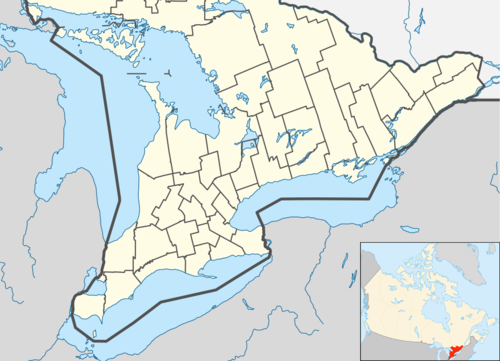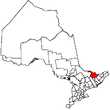Algonquins of Pikwàkanagàn First Nation
The Algonquins of Pikwàkanagàn First Nation, formerly known as the Golden Lake First Nation, are an Algonquin First Nation in Ontario, Canada. Their territory is located in the former township of South Algona (now part of Bonnechere Valley) in the Ottawa Valley on Golden Lake.
Pikwàkanagàn | |
|---|---|
| Pikwakanagan (Golden Lake 39) Indian Reserve | |
 Pikwàkanagàn | |
| Coordinates: 45°33′N 77°13′W | |
| Country | |
| Province | |
| County | Renfrew |
| First Nation | Algonquins of Pikwàkanagàn |
| Area | |
| • Land | 7.45 km2 (2.88 sq mi) |
| Population (2011)[1] | |
| • Total | 432 |
| • Density | 58.0/km2 (150/sq mi) |
| Website | www.algonquinsof pikwakanagan.com |
As of October, 2008, the registered population of the First Nation was 1,992 people, of which only 406 people lived on their own reserve.
History
The name "Pikwàkanagàn" comes from the Algonquin, meaning "[beautiful] hilly country [covered] in evergreens" or simply "a hilly place".
In September 1856, five families petitioned the Governor General for a grant of 200 acres (81 ha) of land per family since their hunting grounds had been opened up for settlement and sale. Their request was denied. However, on September 17, 1873, the Algonquins of Pikwàkanagàn received Crown Patent to a total of 1,561 acres (632 ha), which became the First Nation's reserve.
Many Algonquin skills are still practiced among the Algonquins of Pikwàkanagàn though assimilation with surrounding non-native communities and enforced Residential schooling has affected their people, including several generations of their population raised without their culture, language and traditions. Now efforts are being made to bring culture, language and tradition into the forefront of their lives. Community members still participate in harvesting for food and fur, an annual Pow-wow unites people and tribes, food and crafting skills have survived and language skills though greatly diminished are being introduced into the community again.
Families
Commonly known families associated with the Algonquins of Pikwàkanagàn include: Amikons, Aird, Baptiste, Benoit, Bernard, Commanda, Cooke, Jocko, Kohoko, Lavalley, Leclaire, Meness, Pappin, Rabishaw, Sarazin, Tennisco, Timmerman, Two-Axe and Whiteduck.
Culture
Omàmiwininì Pimàdjwowin (the Algonquin Way Cultural Centre) and the Manido Chiman Museum are located at 1674 Mishomis Inamo, Pikwakanagan First Nation.
Governance
The First Nation's leadership is determined though the Custom Electoral System, consisting of a chief and six councillors. The current Chief is Wendy Jocko. The councillors are Jim Meness, Dan Kohoko, Ron Bernard, Wendy Jocko, Barbara Sarazin and Steven Benoit. Their term will end in March 2020.
The Council is an independent member of the Union of Ontario Indians, a tribal political organization representing many of the First Nations not located in the far northern Ontario.
Services
- Administration
- Council House
- General Government
- Education
- Finance
- Economic Development
- Economic Initiatives
- Lands, Estates and Membership
- Health
- Health Centre
- Medical Transportation Services
- Native Alcohol and Drug Abuse Worker
- Public Works
- Social Services
Reserve
The First Nation have reserved for themselves the Pikwakanagan Indian Reserve, formerly known as Golden Lake 39 Indian Reserve. Their reserve of 688.8 hectares (1,702 acres) is adjacent to the hamlet of Golden Lake which is located between the villages of Killaloe and Eganville, about 40 kilometres (25 mi) south of Pembroke. The land straddles the south shores of Golden Lake and the Bonnechere River.
External links
- Algonquins of Pikwàkanagàn First Nation website
- Profile of the First Nation from the Department of Indian Affairs and Northern Affairs
- Omàmiwininì Pimàdjwowin: The Algonquin Way Cultural Centre
References
- "Pikwakanagan (Golden Lake 39) census profile". 2011 Census of Population. Statistics Canada. Retrieved 17 June 2015.
